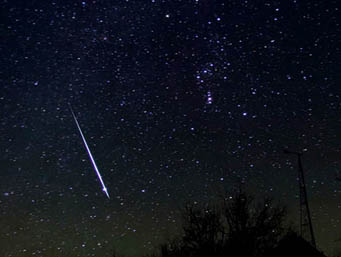
During the 2004 Geminid meteor shower, Alan Dyer caught a bright fireball with a tripod-mounted digital camera. He used a wide-field, 16-mm lens for a 1-minute exposure at f/2.8 with an ISO setting of 800. Expect to shoot a lot of frames before you get this lucky. Click image for larger view.
Alan Dyer
Any time you’re outside at night, watch out for meteors — streaks of light that look like “shooting stars.” (For more information, see Meteors: A Primer and the other articles in the Meteor section of our website.) Most nights a half-dozen sporadic (random) meteors appear hourly. But several times a year Earth encounters a stream of debris left by a passing comet. The result is a meteor shower — the hourly rates rise and the meteors seem to fly away from a common point in the sky called the radiant.
Meteor showers peak during the pre-dawn hours on the dates listed below, though they're typically active a few nights before and after the peak date. For the best possible viewing experience, find a dark location, make yourself comfortable in a reclining chair, and wear plenty of warm clothing.
| 2008 Meteor Showers | |||
| Shower |
Radiant and direction |
Morning of maximum |
Hourly rate |
| Quadrantid | Draco (NE) | Jan. 4 | 100 |
| Lyrid* | Lyra (E) | Apr. 22 | 10-20 |
| Eta Aquarid | Aquarius (E) | May 5 | 20-40 |
| Delta Aquarid | Aquarius (S) | July 29 | 20 |
| Perseid | Perseus (NE) | Aug. 12 | 60 |
| Orionid* | Orion (SE) | Oct. 21 | 10-15 |
| Leonid* | Leo (E) | Nov. 17 | 10 |
| Geminid* | Gemini (S) | Dec. 14 | 75 |
| * Moonlight will wash out fainter meteors in these showers. |
January 4: The Quadrantids
This short, sharp shower peaks around 2 a.m. Eastern time with as many as 100 meteors an hour streaming from its radiant in northern Boötes. The waning crescent Moon rises late, so its light won’t interfere.
April 22: The Lyrids
Many of the dozen or so meteors per hour spawned by this shower will be washed out by the glare from the nearly full Moon. If you’re looking anyway, the radiant is near the Hercules-Lyra border.
May 5: The Eta Aquarids
This shower is good for Northern and Southern Hemisphere observers though the radiant, in the Water Jar of Aquarius, rises late for northerners. But 20-plus meteors an hour should be visible in a moonless sky.
July 29: The Delta Aquarids
Southern Hemisphere skywatchers have the best view because the radiant, near Delta Aquarii, is below the celestial equator. Still, northern observers should spot many of the predicted 20 or so hourly meteors, and light from the crescent Moon won’t interfere.
August 12: The Perseids
The Perseid shower is a popular display because it offers plenty of meteors (up to 60 an hour) under a summer sky. Showtime begins after 1:30 a.m. with the departure of the 10-day-old Moon. The radiant is near the Double Cluster in Perseus.
October 21: The Orionids
Light from the last-quarter Moon will hide some of the 10 to 15 hourly meteors that stream from the shower’s radiant, located above Orion’s bright reddish star Betelgeuse.
November 17: The Leonids
This weak display (less than a dozen an hour) is also bothered by moonlight. The radiant is in Leo’s Sickle.
December 14: The Geminids
With an average of 75 meteors per hour radiating from near the bright star Castor, this shower is usually one of the year’s best. But the presence of the Moon, a mere two days past full, will spoil the show though bright meteors will pierce the moonlight.
 0
0









Comments
You must be logged in to post a comment.